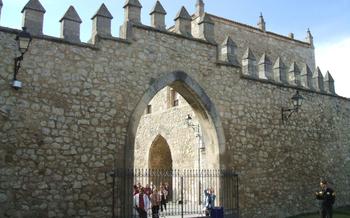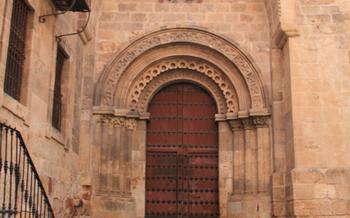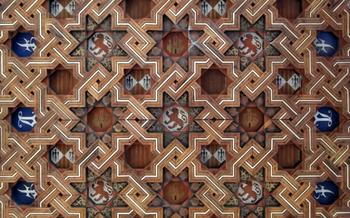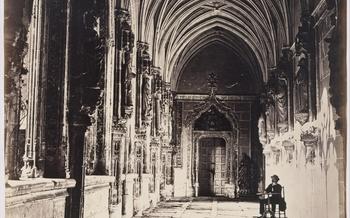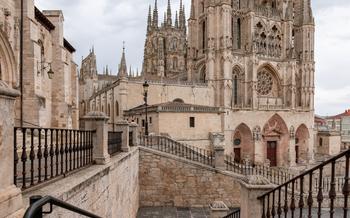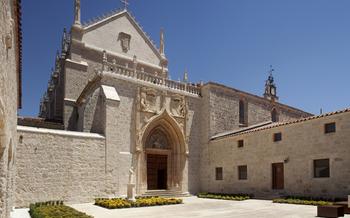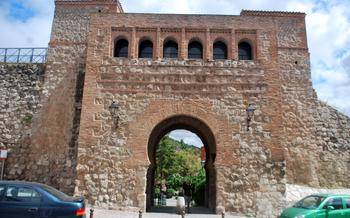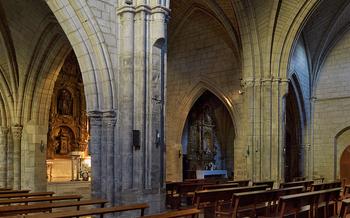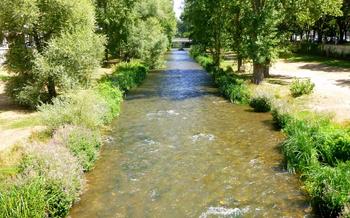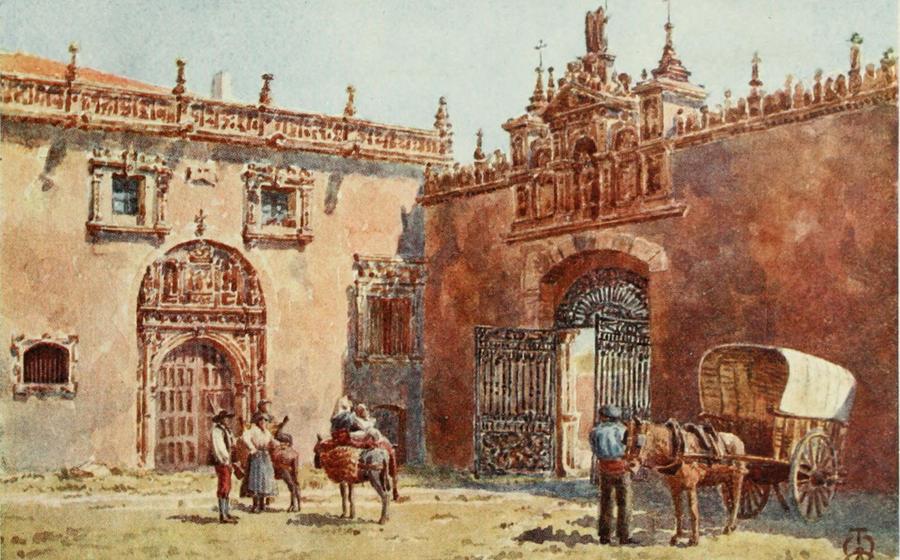
Hospital del Rey
- The History of the Hospital del Rey
- The Architecture of the Hospital del Rey
- The Collections of the Hospital del Rey
- The Educational Programs of the Hospital del Rey
- The Research Programs of the Hospital del Rey
- The Hospital del Rey as a Tourist Destination
- The Hospital del Rey and the Community
- The Future of the Hospital del Rey
- Hospital del Rey: A Hidden Gem
- The Chapel of the Hospital del Rey
- The Courtyard of the Hospital del Rey
- The Gardens of the Hospital del Rey
- Insider Tip:
- The Library of the Hospital del Rey
- Insider Tip
The History of the Hospital del Rey
The Hospital del Rey, or Hospital of the King, is a historic hospital located in the city of Burgos, Spain. It was founded in 1196 by King Alfonso VIII of Castile and was originally intended to provide care for pilgrims on the Way of Saint James. Over the centuries, the hospital has undergone many changes, but it has always remained a vital part of the community.
In the 13th century, the hospital was expanded to include a chapel and a courtyard. In the 16th century, a new wing was added to the hospital, and in the 18th century, the hospital was completely rebuilt. The hospital continued to operate throughout the 19th and 20th centuries, and in 1995, it was declared a national monument. Today, the Hospital del Rey is a museum and a cultural center, and it is one of the most popular tourist attractions in Burgos.
The Architecture of the Hospital del Rey
The Hospital del Rey is a stunning example of Gothic architecture. The building was designed by the architect Juan de Colonia, who also worked on the Cathedral of Burgos. The hospital is made of limestone and features a mix of Gothic and Renaissance elements. The main entrance to the hospital is through a pointed archway, which is flanked by two towers. The towers are decorated with intricate carvings and sculptures. The interior of the hospital is just as impressive as the exterior. The main courtyard is surrounded by a series of arcades, which are supported by slender columns. The arches are decorated with a variety of motifs, including geometric patterns and floral designs. The hospital also features a number of beautiful chapels, which are decorated with frescoes and stained glass windows.
The architecture of the Hospital del Rey has been influenced by a number of factors. The hospital was built during the reign of the Catholic Monarchs, who were strong supporters of the Gothic style. The hospital was also influenced by the work of Juan de Colonia, who was one of the most important architects of the Spanish Renaissance. The architecture of the Hospital del Rey is a testament to the skill and artistry of the builders who created it.
The Collections of the Hospital del Rey
The Hospital del Rey houses a diverse collection of artifacts and documents that shed light on its rich history and the medical practices of the past. The collection includes a vast array of medical instruments and equipment, such as scalpels, forceps, and syringes, which provide a glimpse into the evolution of surgical techniques. Additionally, the hospital preserves a collection of historical documents, including medical texts, patient records, and administrative papers, which offer insights into the daily operations of the hospital and the lives of its patients.
Of particular note is the hospital's collection of religious art, which includes paintings, sculptures, and tapestries that adorned the hospital's chapel. These artworks not only served to provide spiritual comfort to patients and staff but also reflected the deep connection between religion and medicine in the medieval era. The collection also boasts a remarkable collection of antique furniture, which includes beds, chairs, and cabinets that were used by patients and staff alike. These pieces of furniture offer a glimpse into the daily lives of those who inhabited the hospital and provide a sense of the institution's history and character.
The Educational Programs of the Hospital del Rey
The Hospital del Rey offers a variety of educational programs for people of all ages. These programs are designed to teach visitors about the history, architecture, collections, and research of the hospital.
One of the most popular educational programs is the Hospital del Rey Tour. This tour provides an overview of the hospital's history, architecture, and collections. The tour is led by a knowledgeable guide who can answer any questions that visitors may have.
The hospital also offers a variety of workshops and classes. These workshops and classes cover a wide range of topics, including art history, architecture, and medicine. The workshops and classes are taught by experts in their fields and are a great way to learn more about the hospital and its collections.
The Hospital del Rey also offers a summer camp for children. The summer camp provides children with a fun and educational experience that includes activities such as arts and crafts, history lessons, and field trips.
The educational programs of the Hospital del Rey are a great way to learn more about the history, architecture, collections, and research of the hospital. These programs are designed for people of all ages and are a great way to spend a day or two in Burgos.
The Research Programs of the Hospital del Rey
The Hospital del Rey is home to a number of research programs that are dedicated to studying the history, architecture, and collections of the hospital. These programs are conducted by a team of scholars and researchers from a variety of disciplines, including history, art history, and archaeology.
The research programs at the Hospital del Rey are funded by a variety of sources, including the Spanish government, the European Union, and private foundations. The research findings are published in a variety of journals and books, and they are also presented at conferences and workshops around the world.
some of the most important findings from the research programs at the Hospital del Rey include:
- The discovery of a number of previously unknown documents that shed light on the history of the hospital.
- The identification of a number of new works of art in the hospital's collection.
- The development of new methods for conserving and restoring the hospital's historic buildings and artifacts.
The research programs at the Hospital del Rey are an important part of the hospital's mission to preserve and promote its history and culture. The findings from these programs help to ensure that the hospital's legacy will continue to be appreciated and enjoyed by future generations.
The Hospital del Rey as a Tourist Destination
The Hospital del Rey is a popular tourist destination for several reasons. First, it is a unique and well-preserved example of medieval architecture. Second, it houses a valuable collection of art and artifacts. Third, it offers a variety of educational programs and exhibitions.
Visitors to the hospital can see a variety of interesting things, including the hospital's chapel, courtyard, gardens, and library. The chapel is home to a number of beautiful works of art, including a 15th-century altarpiece and a 16th-century rood screen. The courtyard is a peaceful oasis in the middle of the city, and the gardens are a great place to relax and enjoy the outdoors. The library contains a collection of over 10,000 books, including many rare and valuable volumes.
The Hospital del Rey is open to the public from Tuesday to Sunday. Admission is free, but donations are welcome. The hospital is located in the heart of the city of Burgos, and it is easily accessible by public transportation.
The Hospital del Rey and the Community
The Hospital del Rey has a long history of working with the community. The hospital provides a variety of services to the community, including medical care, education, and research. The hospital also works with the community to promote health and well-being.
One of the ways that the hospital contributes to the community is through its educational programs. The hospital offers a variety of educational programs for people of all ages, including classes on health and wellness, history, and art. The hospital also offers tours of the hospital and its collections.
The hospital also works with the community to promote research. The hospital conducts a variety of research projects, including studies on the history of medicine, the development of new treatments for diseases, and the impact of the hospital on the community. The hospital also shares its research findings with the community through publications, presentations, and events.
The Hospital del Rey has had a positive impact on the community over the years. The hospital has provided medical care to thousands of people, educated countless individuals, and conducted important research. The hospital has also helped to promote health and well-being in the community.
The hospital faces a number of challenges in working with the community. One challenge is the need to balance the needs of the hospital with the needs of the community. The hospital also needs to find ways to make its services accessible to everyone in the community, regardless of their income or background.
Despite these challenges, the Hospital del Rey remains committed to working with the community. The hospital believes that it has a responsibility to serve the community and to improve the health and well-being of everyone in the community.
The Future of the Hospital del Rey
The Hospital del Rey has a bright future ahead of it. The hospital is currently in the midst of a major renovation project that will see the addition of new exhibition space, a new research center, and a new educational center. The renovation project is expected to be completed in 2025, and it will allow the hospital to continue to serve the community in an even more effective way.
In addition to the renovation project, the hospital is also working on a number of new initiatives that will help it to reach new audiences and have a greater impact on the community. These initiatives include:
- Developing new educational programs that will teach visitors about the history of medicine and the role of the hospital in the community
- Expanding the hospital's research programs to include new areas of study, such as the history of nursing and the development of new medical technologies
- Working with the community to develop new ways to use the hospital's resources to benefit the community
The Hospital del Rey is a valuable asset to the community, and it is poised to play an even greater role in the years to come. The hospital's commitment to education, research, and community service will ensure that it continues to be a vital part of the community for many years to come.
Hospital del Rey: A Hidden Gem
The Hospital del Rey is a hidden gem in the city of Burgos. It is a former hospital that has been converted into a museum and cultural center. The hospital was founded in the 12th century by King Alfonso VIII and was used as a hospital for over 800 years. It is one of the best-preserved medieval hospitals in Europe and is a UNESCO World Heritage Site.
The hospital is a hidden gem because it is not well-known to tourists. It is located in a quiet neighborhood of Burgos, and it is not as crowded as some of the other tourist attractions in the city. This makes it a great place to visit if you are looking for a more peaceful and relaxed experience.
The hospital is also a hidden gem because it is full of surprises. The exterior of the hospital is simple and unassuming, but the interior is full of beautiful architecture, art, and history. The hospital has a large courtyard, a chapel, a library, and a museum. The museum has a collection of medical instruments, surgical tools, and other artifacts from the hospital's history.
The Hospital del Rey is a unique and fascinating place to visit. It is a place where you can learn about the history of medicine, see beautiful architecture, and experience the culture of Burgos.
The Chapel of the Hospital del Rey
The Chapel of the Hospital del Rey was built in the 13th century in the Gothic style. It is one of the most important examples of Gothic architecture in Spain. The chapel is decorated with beautiful stained glass windows, sculptures, and paintings. It is also home to the tomb of King Alfonso VIII of Castile, who founded the hospital.
The chapel is used for religious services and concerts. It is also a popular tourist destination. Visitors can admire the beautiful architecture and artwork, and learn about the history of the hospital. The chapel is a unique and special place that is well worth a visit.
The chapel has been restored several times over the years, but it has retained its original Gothic style. The most recent restoration was completed in 20The chapel is now in excellent condition and is open to the public.
The Courtyard of the Hospital del Rey
The courtyard of the Hospital del Rey is a beautiful and tranquil space that offers a respite from the hustle and bustle of the city. It was built in the 16th century and features a Renaissance-style arcade that surrounds a central fountain. The courtyard is planted with a variety of flowers and trees, and it is a popular spot for visitors to relax and enjoy the scenery.
History of the Courtyard
The courtyard was built at the same time as the rest of the hospital, and it was originally used as a place for patients to walk and get some fresh air. In the 18th century, the courtyard was remodeled, and a new fountain was added. The courtyard was also used as a place for celebrations and events.
Interesting Features of the Courtyard
One of the most interesting features of the courtyard is the Renaissance-style arcade. The arcade is made up of a series of arches that are supported by columns. The arches are decorated with intricate carvings, and the columns are made of a variety of materials, including marble and granite. The fountain in the center of the courtyard is also a beautiful sight. The fountain is made of bronze, and it is decorated with sculptures of cherubs and dolphins.
Current Use of the Courtyard
Today, the courtyard is used as a place for visitors to relax and enjoy the scenery. It is also used for events and celebrations. The courtyard is a popular spot for weddings and other special events.
Challenges Facing the Courtyard
One of the biggest challenges facing the courtyard is the need for ongoing maintenance. The courtyard is a large space, and it requires a lot of work to keep it looking its best. The courtyard is also exposed to the elements, and it can be damaged by rain, wind, and snow.
Despite the challenges, the courtyard of the Hospital del Rey remains a beautiful and tranquil space that is enjoyed by visitors from all over the world.
The Gardens of the Hospital del Rey
The gardens of the Hospital del Rey are a beautiful and tranquil oasis in the heart of the city. They were created in the 16th century by the hospital's founder, Cardinal Juan de Torquemada. The gardens were originally used to grow medicinal herbs for the hospital's patients, but they have since been transformed into a public park.
The gardens are home to a wide variety of plants and flowers, including roses, lilies, and lavender. There are also several fountains and statues in the gardens, as well as a small pond. The gardens are a popular spot for locals and tourists alike to relax and enjoy the outdoors.
The gardens are open to the public every day from dawn to dusk. Admission is free.
Insider Tip:
The best time to visit the gardens is in the spring or summer, when the flowers are in bloom. If you are visiting the gardens in the summer, be sure to bring a hat and sunscreen, as there is little shade in the gardens.
The Library of the Hospital del Rey
The library of the Hospital del Rey is one of the most important medical libraries in Spain. It was founded in the 16th century and contains over 100,000 volumes on a wide range of medical topics. The library is housed in a beautiful building that was once part of the hospital. The building has been carefully restored and now provides a modern and comfortable space for researchers and students.
The library's collection includes rare books, manuscripts, and journals from all over the world. It is a valuable resource for anyone interested in the history of medicine. The library also has a large collection of modern medical books and journals, which are used by researchers and clinicians from all over the region.
The library is open to the public and offers a variety of services, including reference assistance, interlibrary loan, and document delivery. The library also hosts a number of events throughout the year, such as lectures, workshops, and exhibitions.
The library of the Hospital del Rey is a valuable resource for anyone interested in the history of medicine or in current medical research. It is a beautiful and historic building that is well worth a visit.
Insider Tip
- The best time to visit the Hospital del Rey is during the spring or fall, when the weather is mild.
- Visitors should not miss the chapel, the courtyard, the gardens, and the library.
- To save money, visitors can take advantage of the free admission on Sundays.
- Some common mistakes that visitors make include not booking a tour in advance, not wearing comfortable shoes, and not bringing a camera.
